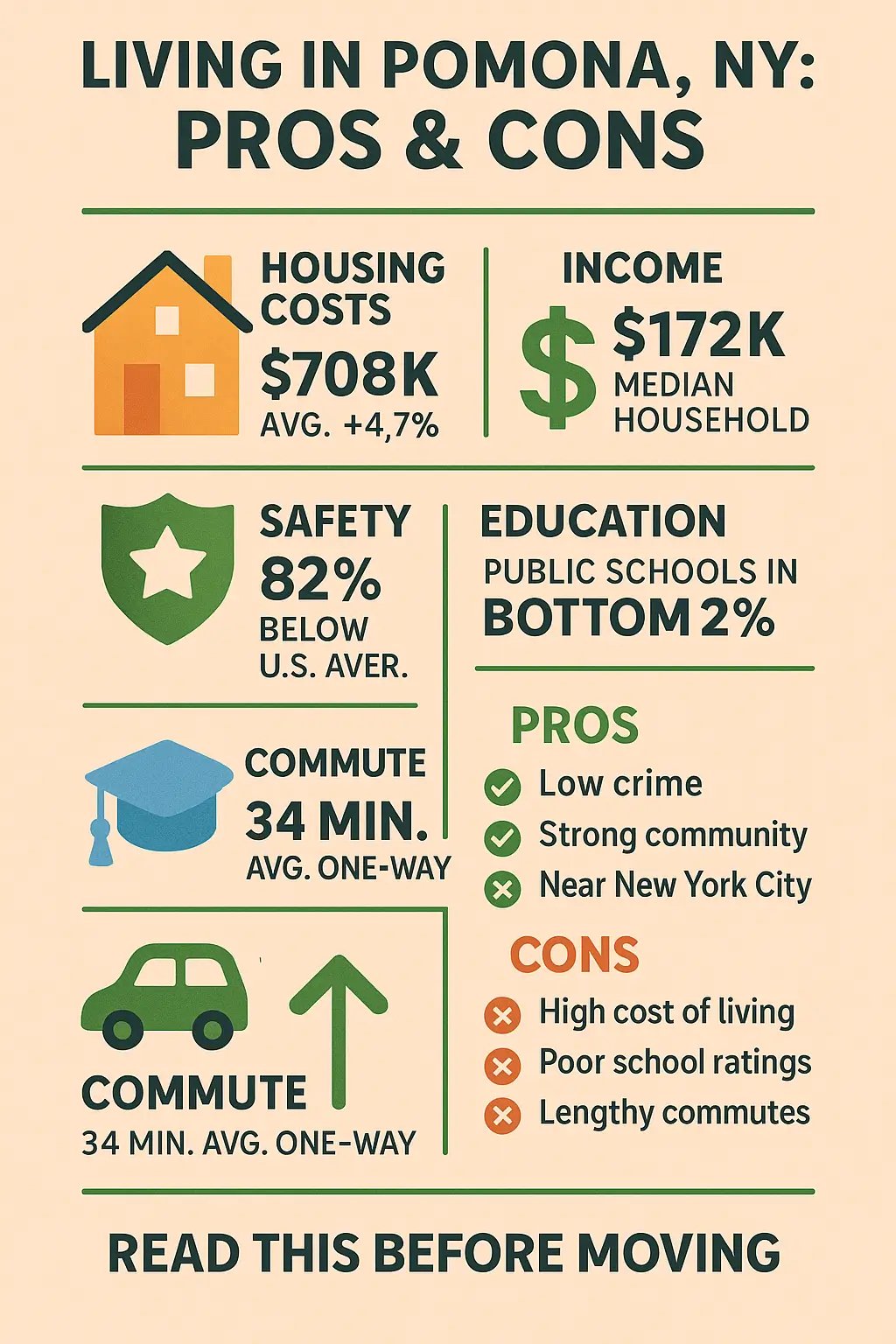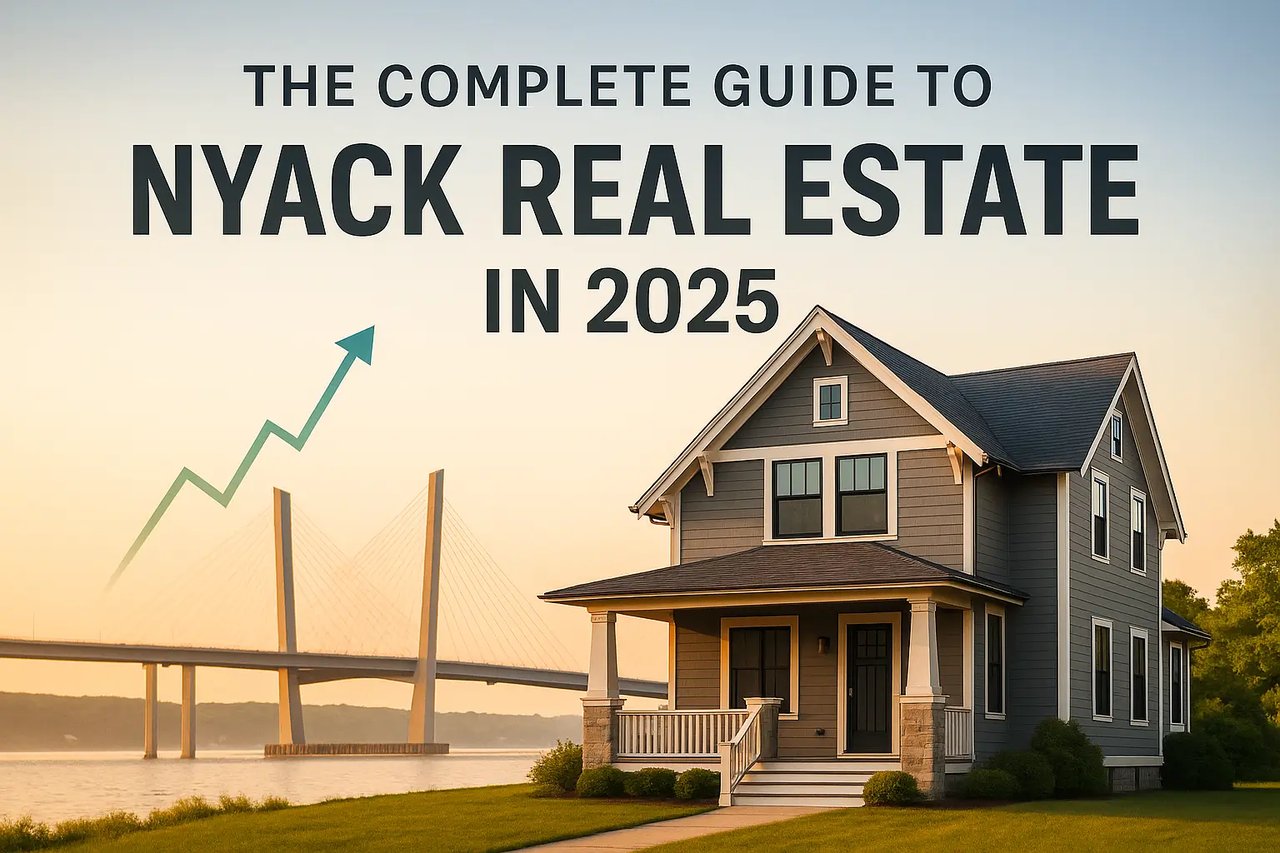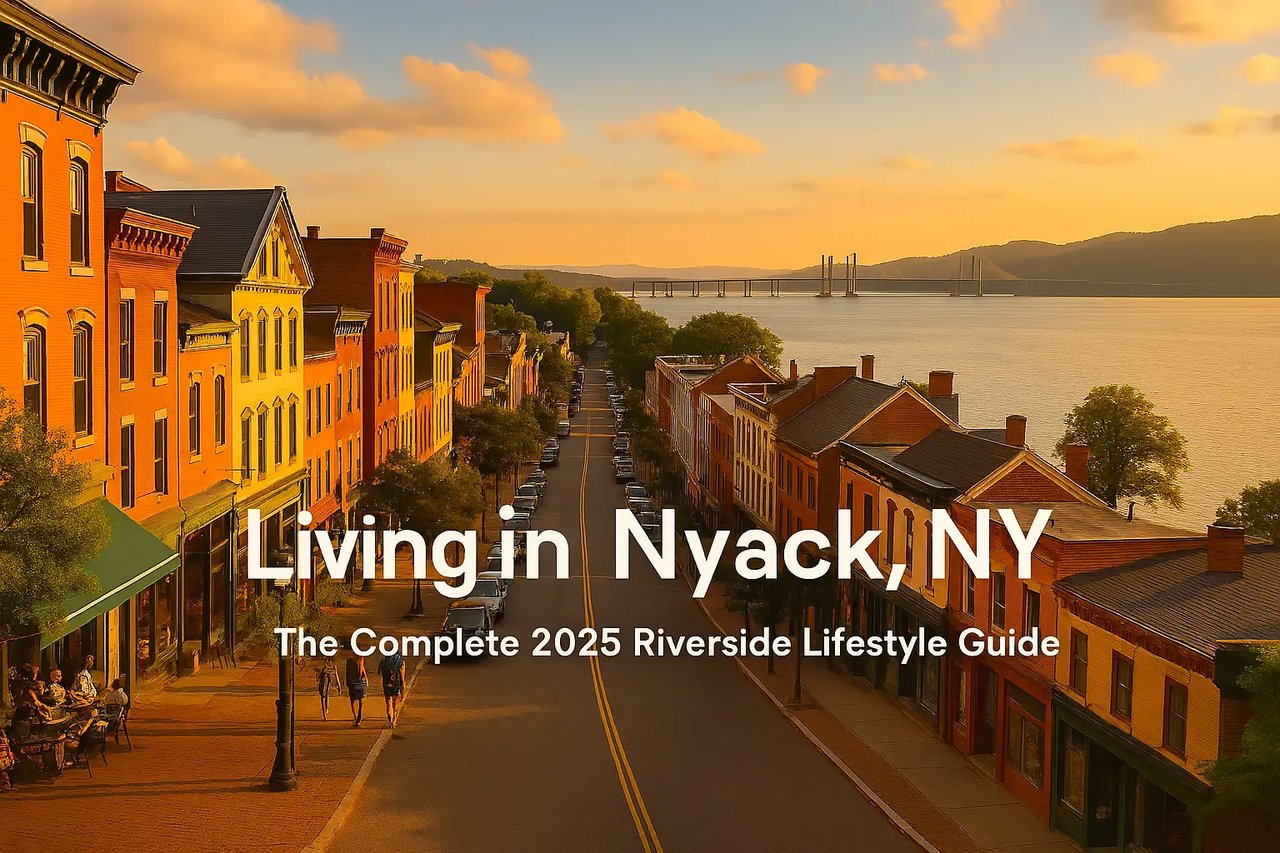Thinking about moving to Pomona New York? You're considering one of the best suburbs in Rockland County and one of the area's best-kept secrets. But before you fall in love with those tree-lined streets and charming neighborhoods, there's a lot you need to know about the pros and cons of living in Pomona NY. As someone who's researched every corner of this community, I'm sharing the unvarnished truth about what it's really like to call Pomona home.
Picture this: You wake up to birds chirping outside your window, kids playing safely in the streets, and a commute that, while long, connects you to the economic powerhouse of New York City. That's the Pomona promise. But like any relationship, there are beautiful moments and challenging ones. Let me walk you through both.
Why Pomona Captured My Attention (And Why It Might Capture Yours)
Nestled in the heart of Rockland County, Pomona isn't just another suburban community. This village of 3,916 residents has quietly become a magnet for families, young professionals, and retirees who've discovered something special here. What started as apple orchards (hence the name, after the Roman goddess of fruit trees) has evolved into a diverse, thriving community that somehow maintains its small-town soul.
The story of Pomona's incorporation in 1967 always fascinates me. Actor Burgess Meredith actually helped fund the village's creation, believing in its potential long before most people had even heard of it. That vision has proven remarkably prescient.
Walking through Pomona today, you'll notice something unique: genuine diversity that works. The community is 60% White, 18.45% Asian, and 10.86% Black or African American, with nearly 20% of residents born outside the country. This isn't the kind of forced diversity you see in some planned communities. It's organic, authentic, and it creates a richness that residents genuinely appreciate.
The Housing Reality: Let's Talk Numbers (And What They Really Mean)
Here's where I need to be completely honest with you. If you're looking for affordable housing, Pomona might break your heart. But if you can swing it, the investment makes sense for many people.
The Current Market Landscape
As of 2025, the average home value sits at $708,552. Yes, you read that correctly. That's a 4.7% increase from last year alone, positioning Pomona among America's most expensive real estate markets. But here's what those numbers don't tell you: the median sold price was $400,000 in May 2025, suggesting there's still variety in the market depending on what you're looking for.
The market has been doing that dance between favoring buyers and sellers throughout 2024-2025. With only 41 Pomona NY homes for sale available in May 2025 (down 16.3% from the previous month), competition remains fierce. If you're serious about buying here, come prepared to move quickly and with your finances in order.
Renting: The Harsh Reality Check
For renters, I won't sugarcoat this: Pomona is expensive. The average rent of $2,121 per month is 36% higher than the national average. Here's how it breaks down:
- One-bedroom apartments: $2,121
- Two-bedroom apartments: $2,919
- Three-bedroom rentals: $4,320 or more
To afford the average rent comfortably, you'll need to earn about $84,840 annually. That's assuming you follow the standard advice of spending no more than 30% of your income on housing.
But here's an interesting insight: 93.6% of Pomona residents own their homes. This isn't just about wealth; it reflects the community's stability and long-term thinking. People don't just move to Pomona; they put down roots.
The Income Picture: Why People Can Afford to Live Here
The high housing costs make more sense when you understand Pomona's income dynamics. The median household income reached $172,188 in 2023, while individual median income stands at $75,714. That's 61% higher than the state average.
With a poverty rate of just 1.47%, Pomona represents economic stability in uncertain times. The average per capita income of $81,601 explains how residents manage the high cost of living. This is a community of professionals, entrepreneurs, and established families who've built financial security.
However, the cost of living at 110.7% of the national average means that even high earners feel the pinch. Everything from groceries to utilities carries a premium in this area.
Education: The Elephant in the Room
I wish I could paint a rosy picture of Pomona's education system, but honesty compels me to share the challenges alongside the opportunities.
The Public School Challenge
Pomona Middle School ranks in the bottom 1.7% of New York middle schools. The statistics are sobering:
- Math proficiency: 5% (compared to 46% state average)
- Reading proficiency: 25% (compared to 49% state average)
- Science proficiency: 24% (compared to 78% state average)
The student population is 99% minority (majority Hispanic), and while diversity can be a strength, the academic performance gaps are concerning for any parent.
The North Rockland Central School District, which serves part of the area, ranks #248 among New York school districts with a B grade overall. It's not terrible, but it's not the educational excellence many families expect when paying premium housing prices.
What Smart Parents Do
Many Pomona families take one of three approaches:
-
Private School Investment: Several private institutions serve the area, including religious schools that cater to the community's diversity.
-
Strategic District Shopping: Some families research neighboring districts before choosing exactly where to live within the greater Pomona area.
-
Supplemental Education: Parents invest heavily in tutoring, after-school programs, and educational enrichment to bridge gaps in public education.
The key is going into this with eyes wide open and a plan that fits your family's needs and budget.
Getting Around: The Commute Reality
Let me be straight with you about commuting from Pomona: it's not quick, but it's doable, and many residents have found ways to make it work.
The Daily Journey
The average commute time is 34.30 minutes, significantly longer than the national average of 26 minutes. Some residents report commutes as long as 40 minutes for typical one-way trips. But here's what matters more than the raw numbers: your options and how you choose to use that time.
Your Transportation Options
Driving to NYC: 52 minutes covering 37.9 miles, costing $7-10 in gas and tolls. Many residents use this time for audiobooks, podcasts, or hands-free calls.
Public Transportation:
- ShortLine Hudson bus from Route 202 & Route 306 to Port Authority takes about 1 hour 19 minutes and costs $17-29
- Alternative routes through Suffern with train connections take about 1 hour 54 minutes total
Here's an insider tip: Many successful Pomona commuters treat their commute as "me time." They use it to decompress, learn something new, or mentally transition between home and work life. The key is finding a routine that works for you rather than seeing it as dead time.
The Remote Work Revolution
Here's where Pomona really shines: 16.51% of the workforce works from home, ranking among the highest in the country. The pandemic accelerated this trend, and many residents now enjoy NYC-level salaries while living in Pomona's peaceful environment. If you're in tech, finance, consulting, or another knowledge-based field, this could be your sweet spot.
Safety: Where Pomona Truly Excels
This is where I get genuinely excited about Pomona. The safety statistics aren't just good; they're exceptional.
Crime rates are 82% lower than the national average. Your odds of becoming a crime victim are 1 in 240, compared to the national average of 1 in 44. Both violent and property crime rates sit well below national standards, making Pomona safer than 64% of all U.S. cities.
What does this mean in practical terms? Kids ride bikes freely. Residents take evening walks without concern. Packages sit on porches without disappearing. It's the kind of safety that's becoming increasingly rare in America, and it's one of Pomona's strongest selling points.
Recreation and Community Life: Where Connections Happen
Pomona's recreational offerings reflect a community that values quality of life and family connections.
Parks and Facilities
Herb Reisman Sports Complex serves as the community's athletic heart:
- Little League and baseball fields where weekend games bring families together
- Soccer fields that host competitive leagues and casual pickup games
- Sand volleyball courts, basketball courts, and paved walking paths
- Picnic pavilion that becomes the center of community celebrations
Eugene Levy Memorial Park offers:
- Children's playground that's become a natural meeting place for parents
- Handball courts and exercise trails for fitness enthusiasts
- Jogging and walking paths where you'll recognize familiar faces over time
The community consistently rates these amenities as Grade A, and for good reason. They're well-maintained, thoughtfully designed, and actively used.
The Social Fabric
What makes Pomona special isn't just the facilities; it's how people use them. Residents describe a genuine sense of community where neighbors know each other's names, kids play together across cultural lines, and community events feel authentic rather than forced.
The annual community events, local sports leagues, and informal gatherings create the social connections that many suburbanites struggle to find elsewhere.
Daily Life: The Practical Realities
Shopping and Dining
Pomona's compact size means limited local shopping options. The Evergreen Uptown Shopping Center serves as a local hub, and its transformation to include a kosher supermarket reflects the community's responsiveness to residents' needs.
Dining options showcase the area's diversity, with various cuisines available locally and even more choices in neighboring communities. While you won't find the restaurant density of a major city, the quality of available options often surprises newcomers.
Healthcare and Services
Healthcare requires some planning, as residents often travel to nearby communities for comprehensive medical services. However, basic services are available locally:
- Family medicine practices
- Specialized clinics in surrounding areas
- Pharmacy services including major chains
- Emergency services with reasonable response times
The proximity to larger medical centers provides access to specialized care when needed, but day-to-day healthcare planning requires more coordination than in larger communities.
Climate and Seasons: Year-Round Living
Pomona's humid subtropical climate offers four distinct seasons that many residents genuinely enjoy.
Summer brings pleasant conditions with average highs of 75-83°F and over 10 hours of daily sunshine. It's perfect weather for all those outdoor community activities.
Winter sees average lows of 25-32°F with moderate snowfall averaging 31 inches annually. Snow removal is generally effective, and many residents appreciate the seasonal beauty.
Spring and Fall offer comfortable temperatures ranging 50-75°F with moderate precipitation, creating ideal conditions for hiking, outdoor sports, and community events.
With 2,909 hours of sunshine annually, Pomona provides plenty of bright days to enjoy the outdoor lifestyle that many residents treasure.
Employment Landscape: Where People Work
The local job market offers about 12,799 positions, but Pomona's small size means most residents look beyond the immediate area for career opportunities. This isn't necessarily a disadvantage; it's part of the community's identity as a residential haven for professionals who work elsewhere.
The rise in remote work has been a game-changer. Many residents now enjoy the best of both worlds: career opportunities at the highest levels while living in a peaceful, family-friendly community.
The Honest Assessment: Challenges You Should Know
The Big Five Challenges
-
Housing Costs: With home values exceeding $700,000 and rents over $2,000 monthly, affordability is a real barrier for many families.
-
Educational Concerns: The poor performance of some local public schools creates stress and additional costs for families with school-age children.
-
Limited Local Amenities: You'll need to drive for most daily needs, which can be inconvenient if you prefer walkable communities.
-
Traffic and Commuting: Despite the small-town feel, commute hours bring congestion and stress.
-
Limited Rental Housing: With 94% homeownership, rental options remain scarce, making it difficult for young professionals or temporary residents.
The Advantages That Make It Worth It
-
Exceptional Safety: Crime rates that let you live without fear
-
Strong Community: Genuine connections in an increasingly disconnected world
-
Natural Beauty: Tree-lined streets, parks, and proximity to Harriman State Park
-
Economic Stability: Strong property values and high-income neighbors
-
Strategic Location: Access to NYC opportunities with suburban lifestyle benefits
How Does Pomona Compare to Nearby Towns Like Spring Valley or Chestnut Ridge?
When researching the best suburbs in Rockland County, many families find themselves comparing Pomona to neighboring communities. Understanding these differences is crucial when you're moving to Pomona New York or considering your options in the area.
Pomona vs Spring Valley: The Cultural and Economic Divide
Spring Valley, just minutes from Pomona, presents a dramatically different living experience. While Spring Valley offers more affordable housing options with median home prices around $450,000-500,000, the trade-offs are significant.
Price Differences: Spring Valley homes cost roughly 30-40% less than Pomona NY homes for sale, making it attractive to first-time buyers and younger families. However, property appreciation rates have been slower, and some neighborhoods show signs of declining values.
Community Vibe: Spring Valley has a more urban feel with higher density housing and more diverse commercial areas. The community is predominantly Orthodox Jewish, creating a unique cultural atmosphere that some families love while others find less welcoming to outsiders.
Schools and Safety: This is where the price difference becomes clear. Spring Valley's schools generally underperform compared to Pomona's already-challenged system, and crime rates are notably higher. Many Spring Valley families send children to private schools, erasing much of the housing cost savings.
Walkability: Interestingly, Spring Valley offers better walkability for daily needs, with more local shopping and services within walking distance.
Pomona vs Chestnut Ridge: The Premium Comparison
Chestnut Ridge represents Pomona's main competition among families seeking the best of Rockland County living.
Price and Value: Chestnut Ridge home prices often exceed Pomona's, with many properties in the $800,000-1.2 million range. However, you generally get more house and land for your investment.
School Quality: This is Chestnut Ridge's strongest advantage. The East Ramapo Central School District serves parts of the area with significantly better performance metrics than Pomona's schools. Families serious about public education often choose Chestnut Ridge despite the higher costs.
Community Character: Both communities offer excellent safety and family-friendly environments. Chestnut Ridge feels slightly more exclusive and established, while Pomona maintains more diversity and accessibility.
Commuting: Chestnut Ridge residents face similar commute challenges to NYC, though some areas offer slightly better access to major highways.
The Monsey and New City Alternative
For families considering the broader area, Monsey offers cultural richness within the Orthodox Jewish community but limited appeal for others. New City provides a middle ground with better schools than Pomona but higher prices and less community cohesion.
The Bottom Line: Among nearby options, Pomona offers the best balance of diversity, safety, and community character. While you'll pay premium prices, you avoid the school quality issues of Spring Valley and the exclusivity costs of Chestnut Ridge.
Making the Decision: Is Pomona Right for You?
Understanding the pros and cons of living in Pomona NY becomes clearer when you know your alternatives. Pomona works best for people who:
- Have established careers or remote work flexibility
- Value safety and community over urban amenities
- Can afford the premium lifestyle costs
- Are willing to be strategic about education choices
- Appreciate natural beauty and outdoor recreation
- Want to build long-term equity in a stable community
Pomona might not be ideal if you:
- Need walkable access to diverse shopping and dining
- Require excellent public schools without additional investment
- Prefer shorter commutes to major employment centers
- Are early in your career with limited income flexibility
- Value urban cultural amenities over suburban tranquility
Frequently Asked Questions: The Answers You Really Need
Housing and Financial Planning
Q: What's the realistic minimum household income needed to live comfortably in Pomona?
A: While the median household income is $172,188, families earning $120,000-150,000 can live comfortably if they budget carefully. The key factors are your housing choice (buying vs. renting, home size), education decisions (public vs. private school), and commuting costs. I recommend having at least six months of expenses saved before making the move, as everything from groceries to home repairs costs more here.
Q: Are there any upcoming developments that might affect property values?
A: Pomona's limited available land and zoning restrictions generally protect property values. The community has historically resisted large-scale developments that might change its character. However, regional transportation improvements and the continued growth of remote work could positively impact values. The key is that Pomona maintains its exclusivity through natural limitations rather than artificial ones.
Q: What hidden costs should I budget for that aren't obvious?
A: Property taxes are significant and can surprise newcomers. Private school tuition if you choose that route. Higher utility costs due to larger homes and older infrastructure in some areas. Increased transportation costs for activities and shopping. Home maintenance costs are higher due to the premium market for services. Budget an extra 15-20% beyond your initial estimates for the first year.
Education Strategy
Q: How do successful families handle the education challenges?
A: The most successful families I've observed take a multi-pronged approach. They research specific schools within district boundaries, not just the district overall. They budget for educational supplements like tutoring, test prep, and enrichment programs. Many join parent networks that share resources and recommendations. Some families strategically choose homes near better-performing schools, even if it means a smaller house or longer commute.
Q: Are there any educational advantages that offset the public school concerns?
A: Yes, several. The community's high education level creates informal learning opportunities through neighbors and family friends. Proximity to NYC provides access to world-class museums, cultural institutions, and educational programs. Many residents work in education, technology, or other knowledge-based fields and informally mentor local kids. The safety allows children more independence and outdoor exploration, which has its own educational value.
Community Integration
Q: How long does it typically take to feel integrated into the community?
A: Most families report feeling welcomed within the first few months, but deeper integration takes 1-2 years. The key accelerators are: participating in community sports leagues, volunteering for local events, joining parent groups if you have kids, and being genuinely friendly to neighbors. The community is welcoming but not pushy, so you need to make the first moves. Religious or cultural organizations also provide quick connection points for many families.
Q: What should I know about the cultural dynamics and potential challenges?
A: Pomona's diversity is generally harmonious, but like any community, there are social dynamics to understand. Economic differences are more pronounced than in typical suburbs due to the high cost of living. Some longtime residents worry about overdevelopment, while newer residents sometimes push for more amenities. The key is approaching relationships with respect and genuine interest in understanding different perspectives.
Practical Living
Q: What's the realistic grocery and daily shopping situation?
A: Plan for more driving and higher costs than you might expect. Local options are limited but decent quality. Many residents do major shopping trips to larger stores in nearby communities or buy in bulk to reduce frequency. Online shopping and delivery services are increasingly popular. Budget about 20-30% more for groceries than you'd pay in less expensive areas, and factor in the time cost of shopping trips.
Q: How do residents typically handle healthcare needs?
A: Most residents establish relationships with healthcare providers in nearby larger communities rather than relying solely on local options. This requires more planning and travel time for appointments. Emergency services are adequate, but serious medical issues often mean trips to regional medical centers. Many residents appreciate having established relationships with specialists before they need them. Health insurance networks and provider directories become more important when you're driving 20-30 minutes for most medical care.
Long-term Considerations
Q: What do residents who've lived here 10+ years say about their decision?
A: Long-term residents consistently cite safety, community stability, and property value appreciation as their top satisfactions. Common regrets include not researching school options more thoroughly initially and underestimating the social importance of community involvement. Most say they'd make the same choice again, but with better initial planning. The biggest surprise for many is how much they've come to value the slower pace and natural beauty, even if they initially moved here primarily for practical reasons.
Q: How is Pomona likely to change over the next 5-10 years?
A: Expect continued slow, controlled growth with rising property values. The remote work trend will likely bring more professionals seeking Pomona's lifestyle benefits. Infrastructure improvements are ongoing but gradual. The community's character is well-protected by zoning and resident involvement, so dramatic changes are unlikely. The biggest variables are regional transportation improvements and broader economic trends affecting the NYC metro area.
Your Next Steps: Making an Informed Decision
If Pomona is calling to you, here's how to move forward thoughtfully:
-
Visit Multiple Times: Come during different seasons and times of day. Experience the commute during rush hour. Walk the neighborhoods in the evening to get a feel for community life.
-
Connect with Current Residents: Join local Facebook groups or online communities. Ask specific questions about daily life, not just general impressions.
-
Research Specific Schools: If you have children, research individual schools and visit them. Talk to parents with kids similar ages to yours.
-
Budget Comprehensively: Include all the hidden costs we've discussed. Model different scenarios for housing, education, and lifestyle choices.
-
Consider Your Five-Year Plan: Think about how your career, family, and lifestyle might evolve. Pomona is a long-term commitment given the housing costs.
Pomona, New York, represents a particular American dream: the successful professional family enjoying safety, community, and natural beauty while staying connected to major economic opportunities. It's not for everyone, but for those who fit its profile, it offers a quality of life that's increasingly rare.
The decision to call Pomona home isn't just about finding a place to live; it's about choosing a lifestyle and community that will shape your family's daily experience for years to come. Take the time to understand both the costs and benefits, visit thoughtfully, and make a decision that aligns with your values, finances, and long-term goals.
Whether Pomona becomes your home or teaches you something about what you're really looking for, approaching this decision with complete information puts you in the best position to create the life you want for yourself and your family.





